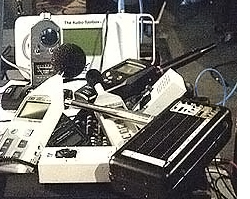
Both styles of display are difficult to read in dim lighting but some SLM’s feature backlit LCD’s for this condition. And either type of display may be quite difficult to read while at arm’s length if the display size is too small.
Equivalent Continuous Sound Level
Although we live sound folk generally believe that we are able to accurately determine the overall sound pressure level when we view the displayed real time values on our SLM’s, these readings are actually no more than a glimpse, or snapshot, of the varying sound pressure levels that we are exposed to.
Due to the dynamic content of the sounds we normally work with (this applies to both speech and music) and our own human shortcomings, we are unable to mentally integrate the frequently changing SPL’s and determine an accurate mean SPL value.
Research into hearing safety and annoyance and the standards that have been developed from this research are based on the accumulative exposure to sound energy over periods of time.
To this end, integrating SLMs have been developed to provide measurements that are conducted over a selected time period and averaged so that they provide an accurate equivalent energy value, designated as Leq (LAeq or LCeq when weighting is employed).
Integrating SLMs also provide Lmax and Lmin values, and the user can choose the time period that the Leq averaging takes place (normally from several seconds to 24 hours).
More and more organizations and governments are adopting this as a more accurate means for establishing risk of hearing damage, community noise standards, annoyance issues, etc.
Although stand-alone integrating SLMs are considerably more expensive than basic SLM’s, some software is available to provide this statistical averaging from the AC output of any SLM. and both the TerraSonde Audio Toolbox and Neutrik Minilyzer provide this function along with other SPL measurements and other useful audio system measurements.
Relative Vs Absolute Measurement
Absolute measurements are those made with calibrated SLMs that provide actual sound pressure levels referenced to 20uPa (0 dB-SPL).
Such absolute SPL measurements may be used with and accurately compared to those provided by other calibrated and equal quality SLMs.
Conversely, measurements made with un-calibrated SLMs or those with of low quality (including less then linear frequency response) do not accurately indicate actual sound pressure levels.
SLMs that have been incorrectly user-calibrated or have simply lost their calibration over time also do not provide accurate absolute SPL values.
Relative measurements are simply comparisons between sound pressure levels and do not require absolute calibration nor other “precision” performance characteristics such as a flat frequency response.
Non-calibrated and lower-quality SLMs do provide meaningful comparative measurements as long as the same SLM is employed for these measurements and the measurements are made in the same manner.
Example: A Radio Shack SLM, which is specified as providing +/-2.0 dB-SPL accuracy and which has a less-than linear frequency response, is still able to provide realistic indication of the changes in relative sound pressure levels even though it does not provide accurate measurement of absolute sound pressure levels.
Likewise, the SLM function contained in Smaart may be used “as is” (without calibration) for accurate relative SPL measurement.
